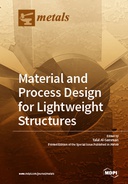Explore

Material and Process Design for Lightweight Structures
Talal Al-Samman
2019
0 Ungluers have
Faved this Work
Login to Fave
The use of lightweight structures across several industries has become inevitable in today’s world given the ever-rising demand for improved fuel economy and resource efficiency. In the automotive industry, composites, reinforced plastics, and lightweight materials, such as aluminum and magnesium are being adopted by many OEMs at increasing rates to reduce vehicle mass and develop efficient new lightweight designs. Automotive weight reduction with high-strength steel is also witnessing major ongoing efforts to design novel damage-controlled forming processes for a new generation of efficient, lightweight steel components. Although great progress has been made over the past decades in understanding the thermomechanical behavior of these materials, their extensive use as lightweight solutions is still limited due to numerous challenges that play a key role in cost competitiveness. Hence, significant research efforts are still required to fully understand the anisotropic material behavior, failure mechanisms, and, most importantly, the interplay between industrial processing, microstructure development, and the resulting properties. This Special Issue reprint book features concise reports on the current status in the field. The topics discussed herein include areas of manufacturing and processing technologies of materials for lightweight applications, innovative microstructure and process design concepts, and advanced characterization techniques combined with modeling of material’s behavior.
This book is included in DOAB.
Why read this book? Have your say.
You must be logged in to comment.
Rights Information
Are you the author or publisher of this work? If so, you can claim it as yours by registering as an Unglue.it rights holder.Downloads
This work has been downloaded 185 times via unglue.it ebook links.
- 35 - pdf (CC BY-NC-ND) at Unglue.it.
Keywords
- Al-Cu-Mg alloy
- aluminium alloy
- aluminum alloy
- automated void recognition
- bending
- ceramic core
- Characterization
- contact heat transfer
- creep aging
- damage
- de-coring
- density
- equivalent strain
- fatigue fracture behavior
- FEA
- Finite Element Model
- formability
- heat transfer
- high pressure torsion extrusion
- hot stamping
- hot working
- HPDC
- hybrid composite material
- in-die quenching
- kinetic analysis
- light metals
- magnesium alloys
- material characterization
- Mechanical properties
- metal flow
- Mg-Al-Ba-Ca alloy
- Microstructure
- multi-output porthole extrusion
- multilayered sheets
- n/a
- non-ferrous alloys
- optimization
- processing
- processing map
- Rolling
- Severe plastic deformation
- shear lap test
- spring-back
- strength
- stress superposition
- surface roughness
- Texture
- thin-walled profile
- transmission line fittings
- V-bending test
Links
DOI: 10.3390/books978-3-03897-959-3Editions


